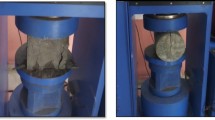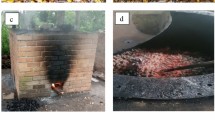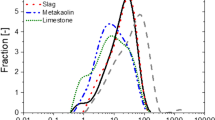Abstract
The properties of high-strength concrete under standard curing condition (20 °C, 95% RH), high-temperature curing condition (50 °C) and temperature match curing condition were comparatively investigated. The cumulative hydration heat of composite binder containing fly ash and silica fume is lower than that of composite binder containing the same amount of slag. Addition of fly ash and silica fume clearly reduces the adiabatic temperature rise of concrete, but adding slag leads to higher adiabatic temperature rise than Portland cement concrete. High-temperature curing condition and temperature match curing condition lead to the sustainable increase in compressive strength of concrete containing mineral admixture, but they hinder the later-age strength development of Portland cement concrete. For cement–slag paste and cement–fly ash–silica fume paste, the non-evaporable water contents increase significantly and the pore structures are much finer under high-temperature curing condition and temperature match curing condition, which negatively affect the pore structure of Portland cement paste. The differences in properties of concrete among three curing conditions become smaller with time. The properties obtained under standard curing condition can approximately reflect the long-term properties of high-strength concrete in the real structure. The concrete prepared with cement–fly ash–silica fume composite binder has the highest compressive strength, finest pore structure and best resistance to chloride permeability under any curing condition. This composite binder is very suitable to prepare the high-strength concrete with large volume.













Similar content being viewed by others
References
Kodur VKR, Bhatt PP, Soroushian P, et al. Temperature and stress development in ultra-high performance concrete during curing. Constr Build Mater. 2016;122:63–71.
An G, Park J, Cha S, et al. Development of a portable device and compensation method for the prediction of the adiabatic temperature rise of concrete. Constr Build Mater. 2016;102:640–7.
Wang Q, Huang Z, Wang D. Influence of high-volume electric furnace nickel slag and phosphorous slag on the properties of massive concrete. J Therm Anal Calorim. 2017;7:1–13.
Bohác M, Palou M, Novotný R, et al. Influence of temperature on early hydration of Portland cement-metakaolin-slag system. J Therm Anal Calorim. 2017;127:309–18.
Lothenbach B, Scrivener K, Hooton RD. Supplementary cementitious materials. Cem Concr Res. 2011;41:1244–56.
Scrivener KL, Juilland P, Monteiro PJM. Advances in understanding hydration of Portland cement. Cem Concr Res. 2015;78:38–56.
Palou MT, Kuzielová E, Novotný R, et al. Blended cements consisting of Portland cement-slag-silica fume-metakaolin system. J Therm Anal Calorim. 2016;125:1025–34.
Gallucci E, Zhang X, Scrivener KL. Effect of temperature on the microstructure of calcium silicate hydrate (C-S-H). Cem Concr Res. 2013;53:185–95.
Wang Q, Feng JJ, Yan PY. An explanation for the negative effect of high temperature at early ages on the late-age strength of concrete. J Mater Sci. 2011;46:7279–88.
Lothenbach B, Winnefeld F, Alder C, et al. Effect of temperature on the pore solution, microstructure and hydration products of Portland cement pastes. Cem Concr Res. 2007;37:483–91.
Kjellsen KO, Detwiler RJ, Gjorv OE. Development of microstructure in pain cement pastes hydrated at different temperatures. Cem Concr Res. 1991;21:179–89.
Shanahan N, Tran V, Zayed A. Heat of hydration prediction for blended cements. J Therm Anal Calorim. 2017;128:1279–91.
Han F, Liu J, Yan P. Comparative study of reaction degree of mineral admixture by selective dissolution and image analysis. Constr Build Mater. 2016;114:946–55.
Kolani B, Buffo-Lacarrière L, Sellier A, et al. Hydration of slag-blended cements. Cem Concr Compos. 2012;34:1009–18.
Fanghui H, Juanhong L, Peiyu Y. Effect of temperature on hydration of composite binder containing slag. J Chin Ceram Soc. 2016;44:1071–80.
Bingöl AF, Tohumcu İ. Effects of different curing regimes on the compressive strength properties of self compacting concrete incorporating fly ash and silica fume. Mater Design. 2013;51:12–8.
Mengxiao S, Qiang W, Zhikai Z. Comparison of the properties between high-volume fly ash concrete and high-volume steel slag concrete under temperature matching curing condition. Constr Build Mater. 2015;98:649–55.
Soutsos M, Hatzitheodorou A, Kwasny J, et al. Effect of in situ temperature on the early age strength development of concretes with supplementary cementitious materials. Constr Buil Mater. 2016;103:105–16.
Dhir RK, Jones MR. PFA concrete: influence of simulated in situ curing on elasto-plastic load response. Mag Concrete Res. 1993;45:139–46.
Han F, Liu R, Wang D, et al. Characteristics of the hydration heat evolution of composite binder at different hydrating temperature. Thermochim Acta. 2014;586:52–7.
Oertel T, Hutter F, Helbig U, et al. Amorphous silica in ultra-high performance concrete: first hour of hydration. Cem Concr Res. 2014;58:131–42.
Rossen JE, Lothenbach B, Scrivener KL. Composition of C-S-H in pastes with increasing levels of silica fume addition. Cem Concr Res. 2015;75:14–22.
Han F, Zhang Z, Wang D, et al. Hydration kinetics of composite binder containing slag at different temperatures. J Therm Anal Calorim. 2015;121:815–27.
Juenger MCG, Siddique R. Recent advances in understanding the role of supplementary cementitious materials in concrete. Cem Concr Res. 2015;78:71–80.
Kishi T, Maekawa K. Thermal and mechanical modeling of young concrete based on hydration process of multi-component cement minerals. In: International RILEM Symposium. 1994.
Han F, He X, Zhang Z, et al. Hydration heat of slag or fly ash in the composite binder at different temperatures. Thermochim Acta. 2017;655:202–10.
Narmluk M, Nawa T. Effect of fly ash on the kinetics of Portland cement hydration at different curing temperatures. Cem Concr Res. 2011;41:579–89.
Taylor R, Richardson IG, Brydson RMD. Composition and microstructure of 20-year-old ordinary Portland cement-ground granulated blast-furnace slag blends containing 0 to 100% slag. Cem Concr Res. 2010;40:971–83.
Lee NK, Lee HK. Influence of the slag content on the chloride and sulfuric acid resistances of alkali-activated fly ash/slag paste. Cem Concr Compos. 2016;72:168–79.
Ismail I, Bernal SA, Provis JL, et al. Influence of fly ash on the water and chloride permeability of alkali-activated slag mortars and concretes. Constr Build Mater. 2013;48:1187–201.
Wongkeo W, Thongsanitgarn P, Ngamjarurojana A, et al. Compressive strength and chloride resistance of self-compacting concrete containing high level fly ash and silica fume. Mater Design. 2014;64:261–9.
Acknowledgements
Authors would like to acknowledge Open Fund of State Key Laboratory of High Performance Civil Engineering Materials (No. 2015CEM010), the China Postdoctoral Science Foundation (Nos. 2015M580992 and 2016T90036) and Fundamental Research Funds for the Central Universities (No. FRF-TP-15-108A1).
Author information
Authors and Affiliations
Corresponding author
Rights and permissions
About this article
Cite this article
Han, F., Zhang, Z. Hydration, mechanical properties and durability of high-strength concrete under different curing conditions. J Therm Anal Calorim 132, 823–834 (2018). https://doi.org/10.1007/s10973-018-7007-3
Received:
Accepted:
Published:
Issue Date:
DOI: https://doi.org/10.1007/s10973-018-7007-3




